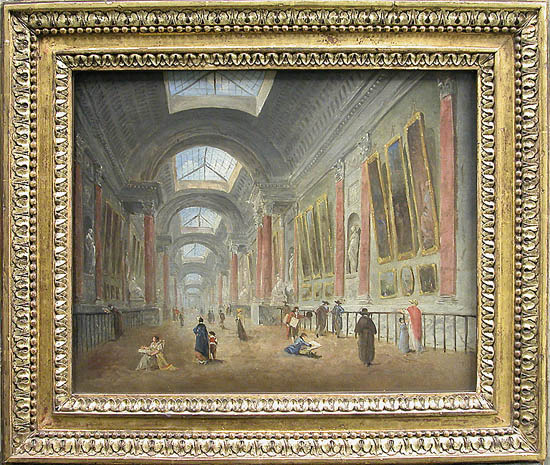At the Louvre after the French Revolution

Hubert Robert, Project for the Grande Galerie of the Louvre, 1796, oil on canvas (Musée du’ Louvre, Paris)
Following his time in prison during the French Revolution, Hubert Robert reassumed his position as a curator and collector for the Louvre Museum in Paris. Robert was, at first, commissioned to redesign the Grande Galerie of the Louvre1, however these plans never came to fruition. Robert was placed with the responsibility of categorizing, managing, and displaying works of art and was thus, deeply involved in the formation of exhibition spaces. Paintings executed by Robert during his employment offer insight into the planned renovations. Two paintings, exhibited together at the Salon of 1796, demonstrate Robert’s own ideas in the remodeling of the museum halls.
Project for the Grande Galerie of the Louvre, painted in 1796, highlights a spacious, arched hallway of an exhibit. A long, diagonal perspective of the hallway with figures in the process of exhibiting paintings on the walls establishes depth in the painting. This painting, aside from demonstrating the artist’s skill, shows the Robert’s involvement and attentiveness in which he reimagined the halls of the Louvre. The museum planners had hoped to include more natural, bright lighting in the exhibition space so as to allow viewers to consume the collection of Royal paintings with ease2. Here, Robert paints an example of what was proposed.
Accompanying and exhibited with the Project for the Grande Galerie of the Louvre was Robert’s Imaginary View of the Grande Galerie of the Louvre in Ruins, offering an imagined view of the museum. In parallel with his previous paintings of ruins, Robert takes liberty in depicting the Grande Galerie in shambles, with the ceiling of the building flayed open to the sky and humans scrambling among the rubble and detritus.
These two paintings serve as a portrait of Robert as a painter. He is a dutiful and popular painter as demonstrated by his many commissions and the trust that is placed on him by institutions. As well, Robert is an independent, creative artist who challenges the idealized. Project promises hope for the future successes of an institution, while his Imagined View seeks to challenge that stability. Robert’s Imagined View, a bleak portrait of a future ravaged by time, opens up numerous interpretations, whether it be a political statement on the future of France post Revolution or a return to his capricci. It is not difficult to see Robert offering a critical undertone in his paintings. If the Louvre represents changing political systems after the French Revolution, Robert questions the merits and longevity such an effort. The juxtaposition of these two paintings offers insight into the artist’s own view of the posterity and stability of France.
KC
______________________________________________________________________________
1Jean Cailleux and Marianne Roland Michel. “From the ‘Museum’ to the Musee du Louvre: Schemes and Transformations in Connexion with Two Paintings by Hubert Robert” The Burlington Magazine, 105, no. 720 (1963), 1
2 Ibid., 1